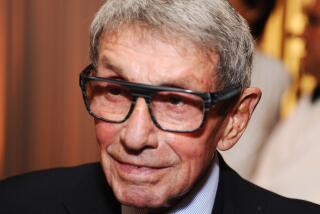Classic Hollywood: Frank Sinatra’s 100th birthday is being celebrated in a big way
Frank Sinatra is the eternal epitome of cool and ring-a-ding charisma.
But for Amanda Erlinger and her older sister A.J. Lambert, Sinatra was not the Chairman of the Board, Ol’ Blue Eyes or the head of the Rat Pack. He was simply Grandpa.
“He was just like probably a lot of people’s grandfather’s,” said Erlinger, 39, the daughter of Nancy Sinatra and the late choreographer Hugh Lambert. “I know it’s hard for a lot of people to believe. He did a lot of stuff with my sister and I — swimming, learning how to dive, how to paint in his art studio and traveling with him. He was so warm, generous and kind with me. Even when he was traveling, he was just a phone call away.”
SIGN UP for the free Classic Hollywood newsletter >>
Tina Sinatra, the singer-actor’s youngest daughter, noted that her father “had a sense of responsibility. Of course, you have heard how loyal he was to people who were loyal to him.”
And every day no matter where he was or how busy, Sinatra called his children — Tina, Nancy and Frank Jr. — on the phone between 5 and 6 p.m. “I’m talking about when we were adults and living our own lives,” said Tina Sinatra, whose 2000 book “My Father’s Daughter: A Memoir” is being reissued. “It was something that intuitively he knew that we relied and depended on.”
This year marks the centennial of Frank Sinatra, who was born Dec. 12, 1915, in Hoboken, N.J., and died on May 14, 1998. During his six-decade-plus career, he performed on more than 1,400 records and won nine Grammy Awards.
He was one of Hollywood’s top movie stars and a surprisingly accomplished actor. He won the supporting actor Oscar for 1953’s “From Here to Eternity” and earned a lead actor Oscar nomination for 1955’s “The Man With the Golden Arm.” He starred in such acclaimed dramas as 1954’s “Suddenly” and 1962’s “The Manchurian Candidate” as well as the popular Rat Pack films, including 1960’s “Ocean’s 11 “ and 1964’s “Robin and the Seven Hoods.”
Sinatra’s centenary is being celebrated in a big way by the Sinatra family — and his millions of fans. Earlier this year, HBO aired Alex Gibney’s two-part documentary “Sinatra: All or Nothing at All.” An “Ultimate Sinatra” four-CD set has been released, as well as a five-film collection on Blu-ray.
Erlinger, who is the family’s photo archivist, co-edited a luxury collector’s edition book, “Sinatra,” that is limited to 1,000 copies. She is also involved in the Grammy Museum’s “Sinatra: An American Icon” exhibition, which opens Oct. 21.
Charles Pignone, who is senior vice president of Frank Sinatra Enterprises, wrote the recently published “Sinatra 100,” which features rare photographs, forewords by Tony Bennett and Steve Wynn and afterwords with the children.
“The whole concept was to be a celebration of the life and career of Frank Sinatra in photos and text told by him and those knew who him,” Pignone said. “I always tried to use his own words.”
Pignone had a lot of access to rare Sinatra material not only from the family’s archives but material uncovered during the production of the Gibney documentary, including “some interviews that Frank had done that had never been heard.”
The massive book — it weighs more than 6 pounds — covers all aspects of Sinatra’s life and work: his childhood; his big band era with Harry James and Tommy Dorsey; his years as the dreamboat of the bobby-sox crowd; his groundbreaking recording and film career; his relationships with his family and friends; his charity work; and his dedication to his craft.
If you want a more sensationalized account of his life and career, including his alleged Mafia ties, affairs and brawls, you won’t find it here.
“If the Mafia made Frank Sinatra, they would have made 100 of him,” said Pignone. “The Mafia couldn’t make people go out and buy millions of albums. They couldn’t sell out the Universal Amphitheatre.”
Erlinger noted that the family is not trying to sugarcoat Sinatra’s life. “Nobody’s perfect,” she said.
“Charlie, myself and everybody — we all worked together to make sure that there are these other sides to him [depicted]. We wanted those things to come through especially this year, so people know just a more personal side. To be honest, he was a pretty private person. He had a public persona and a private persona that he wanted to keep to himself, his family and very close friends.”
More to Read
Only good movies
Get the Indie Focus newsletter, Mark Olsen's weekly guide to the world of cinema.
You may occasionally receive promotional content from the Los Angeles Times.











